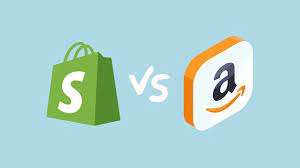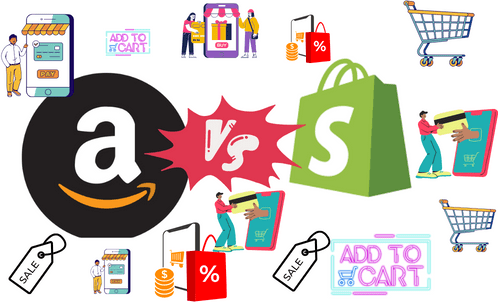Amazon vs Shopify both offer e-commerce platforms, but Amazon is a marketplace, while Shopify provides tools to create your store. Amazon has built-in traffic and competition, while Shopify offers brand customization and independence.
Choosing the right e-commerce platform can shape the success of your online business. Amazon, a dominant online retailer, allows vendors to sell goods on its established marketplace. This comes with the advantage of a massive audience but also means competing with numerous other sellers.
On the other hand, Shopify empowers entrepreneurs to build their own branded online store. It grants full control over the shop’s look and user experience, but it requires effort in marketing to attract customers. The decision between Amazon vs Shopify hinges on your business goals, whether you seek immediate market presence or aim to grow a standalone brand. Each provides distinct benefits and challenges, making it crucial for retailers to consider their long-term strategy and operational preferences.

Credit: www.sostocked.com
The Rise Of E-commerce Giants
The e-commerce landscape has seen a monumental shift as digital storefronts become the new norm in retail. Two platforms, Amazon vs Shopify, stand out from the crowd, not only transforming the way we conduct business but also defining the future of global commerce. Both giants have carved their niches and spurred innovation, leading to the development of an intricate digital marketplace where accessibility, convenience, and variety reign supreme. We’ll explore the histories and growth trajectories that led these platforms to dominate the e-commerce industry.
The Evolution Of Amazon
What began as an online bookstore quickly metamorphosed into an all-encompassing retail behemoth. Amazon’s growth trajectory is a testament to strategic foresight and continuous innovation. Here’s a glimpse into how Amazon rose to the pinnacle of e-commerce:
- User-Friendly Interface: Simplifying online shopping helped Amazon attract millions.
- Prime Membership: Offering exclusive benefits, it created a loyal customer base.
- Vast Inventory: Expanding beyond books, Amazon now sells almost everything.
- Fulfillment Centers: Strategically placed for quick shipping speeds.
- Third-Party Sellers: A marketplace that empowers others to sell alongside Amazon’s products.
- Technological Integration: Pioneering with AI, Alexa, and cloud computing services.
In essence, Amazon’s evolution is a narrative of constant growth and adaptability. By focusing on consumer needs and employing cutting-edge technology, Amazon has secured a dominant position in the global market.
Shopify’s Ascent In The E-commerce Arena
Shopify, on the other hand, empowers businesses and entrepreneurs to create their unique online stores. It’s a platform that lays the groundwork for anyone to become a global seller. Let’s drill down into how Shopify has ascended:
- User Empowerment: Shopify’s tools enable users to build personalized stores with ease.
- Customization and Flexibility: An extensive app store allows for highly tailored e-commerce experiences.
- Direct-to-Consumer Model: Shopify champions the bridge between makers and buyers.
- Global Reach: Merchants from all around the world can access a global market.
- Supportive Community: A robust support network fosters user growth and success.
Shopify’s climb reflects a dedication to democratizing e-commerce and providing a platform that is as versatile as it is accessible. In doing so, it gives users not only a storefront but a full-fledged enterprise solution.
Understanding The Platforms
When entrepreneurs consider taking their business online, the choice of platform can be a pivotal decision with long-term implications. Two popular contenders in the e-commerce arena are Amazon vs Shopify. Each platform comes with a distinctive set of features tailored to different business needs. Grasping the core of Amazon’s Marketplace and Shopify’s offering is essential to make an informed decision that aligns with your business strategy. Let’s delve into the specifics of both platforms.
Amazon’s Marketplace Model
Amazon’s Marketplace is a massive online retail ecosystem where multiple sellers converge to offer their products. This model is robust and designed to help retailers reach Amazon’s extensive customer base. Key features include:
- Access to a large audience with international reach
- Integrated fulfillment services through Fulfillment by Amazon (FBA)
- Competitive environment that can drive price optimization
- A variety of advertising tools to enhance product visibility
- Trust and reliability associated with the Amazon brand
Businesses leveraging Amazon’s Marketplace model benefit from the platform’s immense traffic and customer trust. This dynamic marketplace presents an opportunity, especially for those looking to sell directly to consumers without managing their own website’s technical aspects.
Shopify: A Launchpad For Independent Stores
Conversely, Shopify empowers businesses to create their own independent online stores. This platform is about giving sellers full control over their brand and customer experience. Key highlights of Shopify include:
- Complete customization of your online store’s design and functionality
- Various templates and apps to extend store capabilities
- Direct relationship building with customers without intermediaries
- Integration with multiple sales channels, including Amazon
- Transparent pricing without the need for revenue share on sales
Shopify serves as a customizable base for business owners who prefer to design a unique online presence. The platform’s independence from a central marketplace allows for greater flexibility and brand development.
Comparison Of Business Models
Understanding the business models of Amazon vs Shopify is critical for entrepreneurs and businesses looking to leverage the e-commerce space effectively. Each platform offers a unique approach to online selling, catering to different needs and goals. In this section, we delve into the key aspects that distinguish Amazon’s and Shopify’s methods of generating revenue and their market reach, providing insight into which platform might suit your business best.
Revenue Streams: Amazon Vs. Shopify
Amazon vs Shopify feature distinct revenue models that cater to diverse seller requirements. Amazon’s revenue is primarily generated through its marketplace fees, subscription services, and web services, while Shopify earns through monthly subscription plans, transaction fees, and add-on services.
| Platform | Primary Revenue Streams |
|---|---|
| Amazon |
|
| Shopify |
|
Market Reach And User Base
The market reach of Amazon is vast, providing immediate access to a global audience. Its platform boasts a massive user base with millions of active customers. Conversely, Shopify enables merchants to build an independent online store but requires more effort in driving traffic and establishing a presence. The ability to reach a market is as follows:
- Amazon: Instant access to an international customer base
- Shopify: Opportunity to build a unique brand; reliance on marketing for traffic
Amazon’s ecosystem offers a comprehensive shopping experience which results in high conversion rates. On the other hand, Shopify provides a customizable platform enabling brands to forge deeper customer relationships. Each model offers different advantages:
- Amazon’s marketplace can lead to faster sales due to its reputation and customer trust.
- Shopify’s flexible model empowers business owners to control branding and customer engagement.
The Merchant Experience
Enter the world of online selling, and immediately the choice between Amazon vs Shopify surfaces. Each platform stands as a titan in e-commerce, but the pathways they pave for merchants are distinctively different. Exploring the merchant experience unveils these nuances, with ease of use and control being central to the debate. Will you choose Amazon’s simplicity and vast audience or the customization and independence offered by Shopify? Let’s delve into the facets of setting up shop and controlling the shopping experience on these platforms.
Setting Up Shop: Ease Of Use
Amazon boasts an almost plug-and-play scenario for merchants. The process is straightforward; sign up, list products, and you’re ready to sell. The built-in traffic and customer base are unmatched, presenting an alluring proposition for new sellers. Nonetheless, the simplicity comes with limitations, particularly in brand presence and customer relationship building.
Shopify, on the other hand, offers a more hands-on approach. From choosing your store’s theme to adding products and setting up payment gateways, the platform walks you through each step. While requiring more effort, Shopify equips merchants with comprehensive guides and a supportive community, fostering a manageable setup process even for newbies.
Control And Customization: How Much Is Too Much?
This is where Shopify shines—merchants enjoy immense freedom to mold their stores. You have the power to:
- Design your storefront
- Integrate with various apps
- Employ advanced marketing strategies
Shopify’s robust toolkit caters to those who have a clear vision for their brand’s online presence. While empowering, this level of control requires a significant investment of time and resources to fully capitalize on the platform’s capabilities.
Amazon, conversely, simplifies the process by limiting customization. Merchants follow a preset template, ensuring a consistent buyer experience across the platform. While this streamlines operations, it may leave owners feeling boxed in and unable to express their brand’s unique identity.
Striking the right balance between ease and personalization is key. The decision between Amazon vs Shopify hinges on the merchant’s priorities: Is the convenience of a ready-made audience more tempting, or does the call for brand individuality and customer engagement reign supreme?
The Customer Perspective
When shoppers navigate the vast online marketplace, their journey from browsing to buying is shaped by the platform they use. In the clash of e-commerce titans—Amazon and\ Shopify—understanding the customer perspective is vital. Both platforms endeavor to provide a seamless shopping experience, yet they cater to different desires and expectations. Shoppers’ views on aspects like browsing, purchasing, building trust, and showing loyalty are critical in distinguishing which platform suits their needs better. credit: www.stylefactoryfoundations.com
credit: www.stylefactoryfoundations.com
Shopping Experience On Amazon Vs. Shopify Stores
The shopping experience is where Amazon vs Shopify diverge significantly. Amazon presents a vast marketplace, an all-in-one destination where customers can find a diverse range of products from countless sellers. The key aspects that shape Amazon’s shopping experience include:
- Streamlined Navigation: Intuitive search and filter options make finding products straightforward.
- One-Click Ordering: Convenience is king with Amazon’s patented system that allows quick purchases.
- Customer Reviews: Shoppers rely heavily on the extensive library of user feedback to make informed decisions.
On the flip side, Shopify’s approach is distinct. Each Shopify store offers a unique brand and style curated by the individual seller. Here, the shopping vibe is more akin to visiting a collection of boutique shops:
- Personalized Experience: Stores can offer a tailored experience with unique themes and personal touches.
- Niche Products: Shoppers seeking specialized items may prefer the curated selections of Shopify stores.
- Direct Seller Interaction: Customers can often chat directly with store owners for a more personal service.
Trust And Consumer Loyalty
Trust and consumer loyalty are significant currencies in the online shopping realm. Amazon’s reputation for fast shipping, easy returns, and customer service solidifies its status as a reliable retailer. It’s this reputation that inspires trust and keeps shoppers returning. Key points include:
| Trust Factors | Consumer Loyalty |
|---|---|
|
|
Shopify stores, on the other hand, can leverage the power of brand loyalty. They build trust through unique storytelling, specialized products, and exceptional customer care. Here are some of the strategies Shopify merchants use:
- Brand Authenticity: Developing a genuine brand voice encourages strong customer connections.
- Customer Rewards Programs: Many Shopify stores offer loyalty schemes to reward returning customers.
- Outstanding Support: Personal customer service can create a loyal fan base for a Shopify store.
Strategic Alliances And Partnerships
In the cutthroat world of e-commerce, strategic alliances and partnerships play a pivotal role in propelling businesses towards success. Understanding this, giants like Amazon avs Shopify have fervently embraced collaborations, though their approaches exhibit stark contrasts. Amazon cinches partnerships with high-profile brands, establishing itself as a massive retail powerhouse, while Shopify fortifies its stronghold by offering a plethora of integrations that empower even the smallest of vendors. Let’s delve into the specifics of how each platform leverages strategic alliances to dominate the e-commerce landscape.
Amazon’s Collaborations With Big Brands
Amazon’s strategy of aligning with influential names in various industries has been a game-changer, bolstering its market presence exponentially. By joining hands with leading brands, Amazon ensures that a vast array of products is just a click away from its massive customer base. These collaborations offer mutual benefits:
- Increased Visibility: Partner brands enjoy a spike in visibility by tapping into Amazon’s extensive reach.
- Exclusive Launches: Amazon often becomes the platform for exclusive product releases, which helps in creating buzz and excitement among consumers.
- Customer Trust: Big brands benefit from Amazon’s trust factor, potentially leading to higher sales volumes.
Table 1 below illustrates some of the high-profile partnerships Amazon has cultivated:
| Brand | Sector | Type of Collaboration |
|---|---|---|
| Nike | Fashion and Apparel | Exclusive online storefront on Amazon |
| Apple | Consumer Electronics | Official Apple products retailer |
| Whole Foods Market | Grocery | Acquisition and Integration |
Shopify And Integrations With Third-party Apps
On the flip side, Shopify takes a democratized approach toward strategic growth by empowering merchants with its integration-friendly platform. It does not rely solely on direct alliances with large brands; instead, it focuses on ensuring seamless integration with a host of third-party applications. Here are some benefits that merchants savor through Shopify’s integrations:
- Customizable Experiences: Sellers can tailor their stores with various apps that cater to distinct business needs.
- Operational Efficiency: Integration with apps for accounting, inventory management, and marketing tools saves time and reduces overhead.
- Enhanced Functionality: From adding customer reviews to implementing reward programs, the possibilities for store enhancement are virtually endless.
Below is an example list of third-party app integrations available on Shopify:
- Klaviyo – Email Marketing Automation
- Oberlo – Dropshipping Tool
- Yotpo – Customer Reviews
- Zendesk – Customer Service
Future Directions And Industry Impact
The battle between Amazon vs Shopify continues to shape the future of the e-commerce landscape. Both platforms not only provide avenues for businesses to sell products but also drive innovation in the industry. As they evolve, the anticipation about their impact on global e-commerce grows. Companies and consumers alike are eager to see how these giants will influence shopping trends, technology adoption, and market dynamics in the coming years.
Innovations In E-commerce Technology
The rapid advancement of e-commerce technology steers the competitive edge for Amazon and Shopify. These platforms are not just reacting to consumer demands but are also proactive in shaping user experience. They deploy technologies such as AI-driven recommendation systems, AR/VR for product previews, and seamless integration of various payment gateways to enhance the online shopping experience.
- Amazon leverages its vast amount of data to customize user experiences, offering personalized shopping journeys and speeding up the delivery process with the use of drones and robotics in its fulfillment centers.
- Shopify, on the other hand, empowers merchants with robust tools to create unique digital storefronts, providing flexibility and control over their brand’s online presence. The introduction of Shopify AR has been a game-changer for businesses looking to offer interactive product demonstrations.
Predicting Market Trends: Who Will Dominate?
Predicting which platform will dominate the market is challenging due to the dynamic nature of e-commerce. Amazon boasts a vast customer base and a stronghold in the B2C segment. At the same time, Shopify carves out its dominion by empowering a vast network of independent sellers and focusing on the B2B sphere.
| Amazon | Shopify |
|---|---|
| Massive B2C Marketplace | Strong B2B and D2C Features |
| Prime Delivery and Logistics | Extensive App Marketplace |
| In-House Brand Development | Customizable E-commerce Solutions |
Amazon’s strategy to expand internationally and invest in local economies positions it as a formidable global player. Conversely, Shopify’s focus on streamlining the online retail process with advanced analytics and merchant-friendly features makes it a key player for entrepreneurs and small businesses.
The future of e-commerce is not a question of Amazon vs. Shopify, but rather how each can complement the strengths of the other in shaping consumer behavior and the overall retail ecosystem. Companies seeking online success must consider the unique benefits each platform offers and stay agile to adapt to the ever-changing digital market landscape.

Credit: nationalpositions.com
Frequently Asked Questions On Amazon Vs Shopify
Which One Is Better Amazon vs Shopify?
Choosing between Amazon vs Shopify depends on your business goals. Amazon offers vast customer reach but with higher competition, while Shopify provides more brand control and customization. Consider your priorities for the best platform choice.
How Many People Use Amazon Vs Amazon?
As of early 2023, Shopify boasts over 1. 75 million merchants, while Amazon has over 300 million active customer accounts worldwide.
Does Amazon Accept Shopify?
Yes, Amazon accepts Shopify through its Amazon Sales Channel feature, allowing Shopify store owners to connect and sell products on the Amazon marketplace.
Is Amazon The Best Ecommerce?
Amazon is one of the largest eCommerce platforms globally, known for its vast product variety and quick delivery. However, “best” is subjective and depends on individual shopping preferences and needs.
Conclusion
Navigating the e-commerce arena can be daunting, yet options like Amazon vs Shopify simplify the journey. Your choice hinges on business goals and preferences. Whether it’s global reach with Amazon or brand control through Shopify, success awaits. Forge your path wisely and the rewards will follow.
Embrace the platform that aligns with your vision and watch your online empire flourish.
Click here to learn how to buy products at cheap prices.
